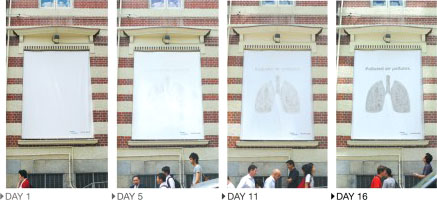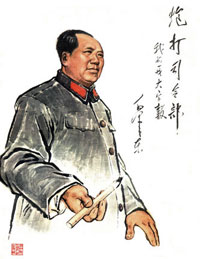March 2008
Knit-in for Peace
On March 19, the Granny Peace Brigade met in the rain in front of the military recruiting station in Times Square to mark the 5th anniversary of the U.S. invasion of Iraq, “knitting ‘stump socks’ for amputee veterans, baby blankets and other items for Iraqi families.” There were a lot of great protest actions Wednesday, but the forceful assertion of care here is striking. Grannies vs. generals; slow, manual creation vs. fast, technological destruction — this is not just non-violence, but perhaps an opposite of violence. Here’s another short video.
Every Wednesday from 4:30 to 5:30 pm Grandmothers Against the War holds a vigil at Rockefeller Center. All are welcome.

It’s an inverse of reverse graffiti, rendering images in polluted urban surfaces by wiping away. For instance, see this video of Alexandre Orion cleaning a São Paulo street tunnel.
Persuasion
From a February 2008 interview with Steve Duenes, graphics director for The New York Times:
From: Nicholas Kristof
Subject: the power of artin september i traveled with bill gates to africa to look at his work fighting aids there. while setting the trip up, it emerged that his initial interest in giving pots of money to fight disease had arisen after he and melinda read a two-part series of articles i did on third world disease in January 1997. until then, their plan had been to give money mainly to get countries wired and full of computers.
bill and melinda recently reread those pieces, and said that it was the second piece in the series, about bad water and diarrhea killing millions of kids a year, that really got them thinking of public health. Great! I was really proud of this impact that my worldwide reporting and 3,500-word article had had. But then bill confessed that actually it wasn't the article itself that had grabbed him so much -- it was the graphic. It was just a two column, inside graphic, very simple, listing third world health problems and how many people they kill. but he remembered it after all those years and said that it was the single thing that got him redirected toward public health.
No graphic in human history has saved so many lives in africa and asia.
A little over the top, but it’s a nice story. Though while Mr. Kristof celebrates, this seems as much an indictment of NY Times coverage of rural poverty. (via)
Updated April 28, 2008: I dug up the graphic in question, posted it here, and added a link in the text above.
 “During the twentieth century, the social and political uses of calligraphy have been radically changed. Calligraphy is no longer an art associated primarily with the traditional scholarly elite. Not only has calligraphy been employed as a tool of revolution, but it has become a popular amateur art practiced by people of all walks of life, and artists have found ways to use it to challenge traditions rather than perpetuate them.…
“During the twentieth century, the social and political uses of calligraphy have been radically changed. Calligraphy is no longer an art associated primarily with the traditional scholarly elite. Not only has calligraphy been employed as a tool of revolution, but it has become a popular amateur art practiced by people of all walks of life, and artists have found ways to use it to challenge traditions rather than perpetuate them.…Even if block-like calligraphy had revolutionary overtones, Mao and other leading revolutionaries wrote in styles much closer to traditional calligraphy. Moreover, even after most people took up writing with pencils and ball-point pens, leading party members continued to do calligraphy with traditional brushes. They would give away pieces of their calligraphy and allowed their calligraphy to be widely displayed.… Mao Zedong’s calligraphy was more widely displayed than that of any other leader.”

